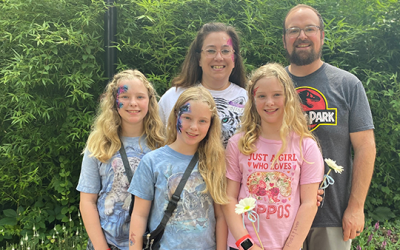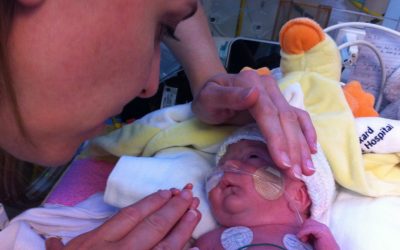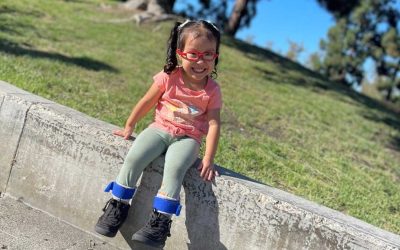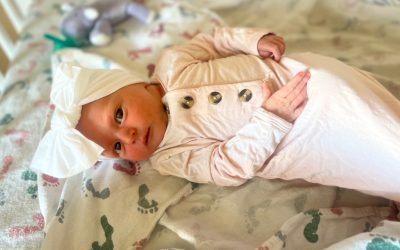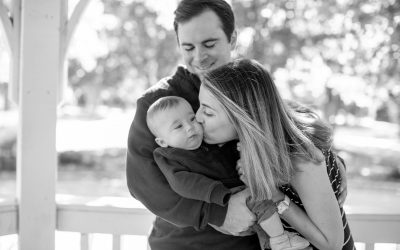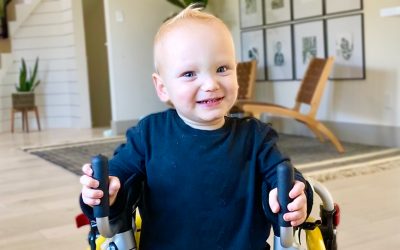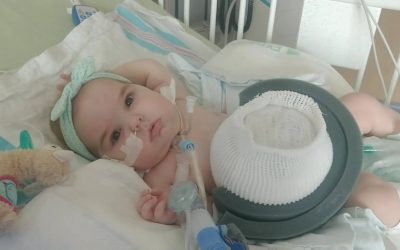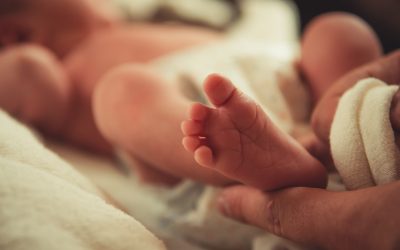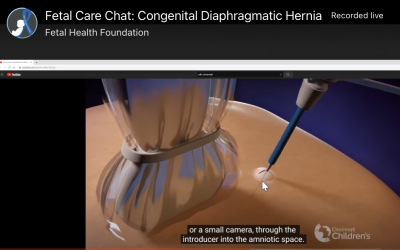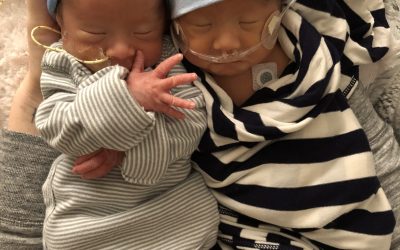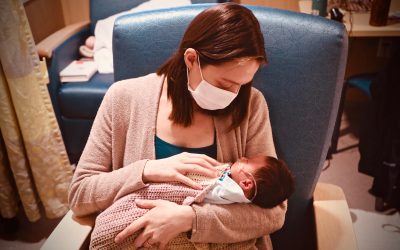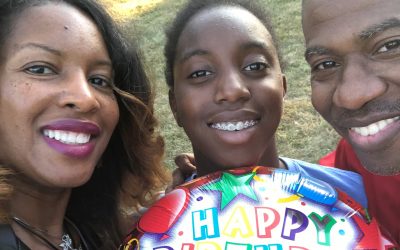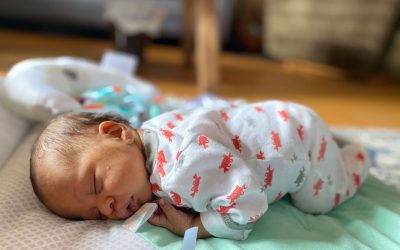Considering Fetal Surgery or a Fetal Care Center? What to Keep in Mind
Fetal Health Foundation Medical Advisory Board member Dr. Timothy Crombleholme, MD, who leads the Fetal Care Center at Connecticut Children’s, shares six important details to consider when your baby needs fetal intervention not just to survive, but to thrive.
TTTS Triplet Parents Reflect on their Daughters’ Surgery and Birth
Performing surgery on triplets is more complex than on twins. In Tiffini’s case, there were two placentas: Hannah had one placenta all to herself, while Sophia and Isabella were sharing the other placenta, albeit unequally. Sophia and Isabella were affected by TTTS when the volume of blood flow across the connecting blood vessels between them became uneven, with Isabella getting too much and Sophia getting too little.
Newborn Survives Fatal Kidney Diagnosis (Bilateral Renal Agenesis) with Help from Stanford Children’s Medicine
Ten years ago, Abigail Beutler was born without kidneys, a condition called bilateral renal agenesis. Against all odds, she’s alive today to play with her Breyer horses, read her favorite Paul Revere adventure book, and challenge her brother in archery. The family was...
Preschooler Thriving Three Years After Fetal Surgery for Spina Bifida
When faced with a severe form of spina bifida, Iliana underwent cutting-edge in-utero surgery at Stanford Medicine Children’s Health. Today she is thriving thanks to her mother’s courageous decision.
“I had the chance to give my baby a better opportunity in life, and I took it.”
A multispecialty Stanford Children’s care team treats baby with rare genetic condition
Alyssa was five months along and an ultrasound revealed that their baby, Nya, had a heart condition, ductus arteriosus.
Alyssa was told that her daughter might need surgery immediately after being born.
Cecelia: Expert Care for Fetal Heart Block Before and After Birth
When Brittany and Nicholas’ unborn baby, Cecelia, was diagnosed with fetal heart block at 24 weeks gestation, their lives changed immediately — in the most literal sense of the word. They lived in Montana and when their doctor first suspected the heart issue, he told...
Charlotte: Surviving a Fetal Omphalocele and Finding Silver Linings
When Charlotte first received an omphalocele diagnosis, her parents didn’t know it’s severity. After one of the longest months of their lives, they got some good news. Maternal fetal medicine specialists at the Colorado Fetal Care Center diagnosed Charlotte with an isolated omphalocele, meaning a small part of her intestine was growing outside her abdomen but it wasn’t affecting other organs.
Fetal Surgery for Spina Bifida: Jaxyn’s Story
Fetal surgery for spina bifida is improving outcomes. The fetal surgeons at Cincinnati Children's Fetal Care Center, who have extensive experience and innovative intervention therapies to help treat spina bifida in utero, recently shared this story of hope with the...
World’s first stem cell treatment for spina bifida delivered during fetal surgery
Three babies have been born after receiving the world’s first spina bifida treatment combining surgery with stem cells. This was made possible by a landmark clinical trial at UC Davis Health.
The new treatment, delivered while a fetus is still in the mother’s womb, could improve outcomes for children with this birth defect.
Pioneering Fetal Medicine Center Gathers Thousands for 26th Annual Family Reunion
The annual reunion brings together a unique community of families who have shared similar struggles. Nearly all the children in attendance had been prenatally diagnosed with a birth defect, such as spina bifida, congenital diaphragmatic hernia, or twin-twin transfusion syndrome, that had potentially devastating outcomes.
Fetomaternal Alloimmunization: Alexandra’s Story
I was diagnosed with fetomaternal alloimmunization, a condition in which a mother’s body creates antibodies against a fetus’ blood antigens. This diagnosis crushed us. My husband and I wanted a lot of children, and now we were left wondering whether we could even have a second.
Hydrops Fact Sheet | UCSF Hydrops Center of Excellence
Hydrops fetalis is a serious condition that affects about 1 in 1,700 pregnancies. For many families, answers about why this condition occurs have been in short supply because the cause is often not identified through standard testing.
Liam: Fetal Surgery for Myelomeningocele (MMC) Spina Bifida Repair
“The doctor came in and handed me a box of tissues,” Katie recalls. “She was saying something about an abnormal pregnancy, shunts, abnormalities of the left leg, club foot. I was in complete shock at that point, and I couldn’t really make out what she was saying because it felt like time was suspended.”
In a span of two hours, their lives had been turned upside down.
Giant Omphalocele: Patient born with organs outside of her abdomen receives transformative care
When Brianne Jacobsen was 20 weeks pregnant, her ultrasound revealed that her developing baby’s internal organs were sticking out of its abdomen. The birth defect, known as an omphalocele, required the higher level of expertise of the UC Davis Fetal Care and Treatment Center team.
Fetal Hydrops: Successful In-Utero Surgery by Oregon Health & Science University’s Fetal Care Team
Fetal hydrops is a rare, but far too often fatal condition. The Fetal Health Foundation is thrilled to share, with their permission, a success story and video from Oregon Health & Science University’s Fetal Care team. Stories like this one, of a healthy baby born...
Congenital Diaphragmatic Hernia (CDH): Fetal Care Chat
Video: Congenital diaphragmatic hernia, or CDH, and treatment options were the topics of conversation for experts from Cincinnati Children’s Hospital
Toddler’s Unstoppable Smile Defies Challenging Start due to LUTO Fetal Diagnosis
“He has so much joy. He’s always smiling, even if it’s a hard day,” says Mandy, Kaleb’s mom. “It’s weird to think of what he has been through at such a young age, but he’s full of life despite all of it.”
How Mono-Mono Twins Overcame Incredible Hurdles
When Beth Kanemoto was pregnant with identical twins Kai and Klay, it felt like every two weeks she received more bad news. First, they learned the pregnancy was high risk. Initially, doctors thought the twins might be conjoined, but they soon learned that instead, Klay and Kai were considered mono-mono twins, meaning that they shared just one amniotic sac with no barrier between them.
Birth Defect Diagnosis: Understanding Your Options
When parents learn that their baby has a birth defect, they experience emotions like confusion, blame, sadness and worry.
As a fetal-pediatric surgeon in the Cincinnati Children’s Fetal Care Center, I encounter families who have just learned that they’re expecting a baby with a birth defect and we’re their next stop….
Advocacy from Anguish: Bethany Weathersby’s Story
After a diagnosis of maternal fetal alloimmunization and losing baby Lucy to hemolytic disease of the fetus and newborn (HDFN), Bethany took action. She made it her mission to ensure that other mothers diagnosed with maternal alloimmunization had education about the risks of the disease and knew the steps for proper medical care and treatment so that their babies could survive HDFN.
Exercise During and After Pregnancy: The Do’s and Don’t’s
Exercising and staying active while pregnant is one of the best things you can do for you and your baby during your pregnancy. If you have a normal, healthy pregnancy and have been cleared by your health care professional, it is recommended that pregnant women get 30 minutes of exercise at least 5 times a week.
Cincinnati Children’s Reaches New Milestone for Improving Outcomes in Babies with Spina Bifida
Cincinnati Children’s, a national leader in prenatal myelomeningocele surgery, recently conducted their 100th prenatal surgical repair. Kelly Song’s daughter was diagnosed with spina bifida at 20 weeks. Read more:
Fetal Care Chat: Bladder Outlet Obstruction/Lower Urinary Tract Obstruction
Fetal Health Foundation founder and Fetal Care Chat host, Lonnie Somers welcomes esteemed doctors from Cincinnati Children's Fetal Care Center as they discuss bladder outlet obstructions and hear an inspiring story about a miracle little boy, JJ....
Tangie’s Story | Grief, Advocacy, Premature Birth and Black Maternal Care in the U.S.
The morning after I unexpectedly gave birth at 27 weeks, my doctor checked in on me and my baby at the Neonatal Intensive Care Unit (NICU). He said he spent the night in the hospital because we were both in critical condition and he didn’t know if either one of us were going to survive.
Baby Jabari gets a second chance at life
The doctor came in and told Trina that the baby likely had a lower urinary tract obstruction, meaning that he had extra tissue blocking his bladder. This didn’t allow urine to pass through, which meant that amniotic fluid wasn’t being produced to help the baby grow in the womb.


